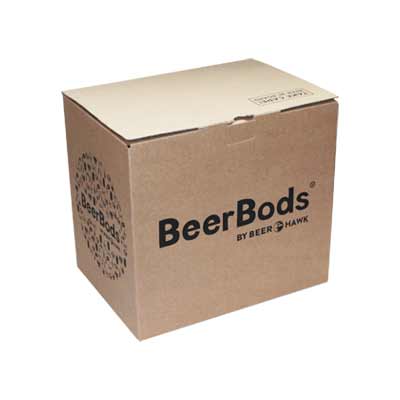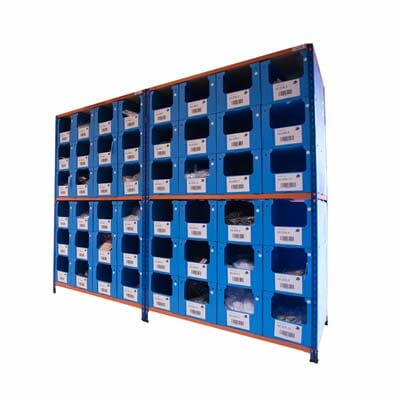Peak season planning
How packaging can help your business cope with increased sales volumes
Are you one of the 40% of retail companies that see more than half of their sales occurring during the final three months of the year? Or an eCommerce business that sees packing times increase significantly during the festive period?
You are not alone.

This guide covers why and how you should prepare your packaging and processes for peak season (well before Peak Packaging Monday). It covers:
- Staff training and engagement.
- The actual packaging you use and how it affects your success.
- Organisational, operational, and logistical considerations.
- Customer experience.
- And much more.
Contents
- What is peak season?
- Peak season planning
- Review last year’s performance
- Train your staff in advance
- Organise the space
- Refine your processes
- Analyse your packaging spend
- Consider custom packaging solutions
- Assess your packaging suppliers
- Consider “Just in Time” supply
- Optimise your logistics
- Be prepared for peak season
What is peak season?
What does peak season mean?
Peak season, also known as the “golden quarter”, is the term given to the busiest time of year for eCommerce and retail businesses. It lasts from October to January, and encompasses events such as Black Friday, Cyber Monday, and the festive trading period.
In essence, peak season is when businesses experience their highest trading volume, with holiday sales accounting for 40% of a retailer’s annual revenue.
For some retailers, the peak can start as early as the “back to school” period, with Halloween and Bonfire Night also being key dates on the calendar.
This makes peak season planning essential, and businesses must ensure that their packaging supplies, processes, and supporting logistics can support the increased demand.
How does peak season affect businesses?
Whilst peak season affects most businesses, those trading online tend to focus considerably more on preparing for peak season.
Online sales now account for approximately 30% of all sales across the Black Friday period 2024. The growth in eCommerce continues even after the shift caused by the pandemic, and peak demand can place considerable strain on a business’s operations.
Ensuring adequate packaging stocks is a crucial consideration. So are packing and fulfilment times: 42% of businesses indicate that packing times increase over the peak season (30% see an increase of over one minute per pack).
Add in complications regarding logistics, staff recruitment (and training), plus customer expectations, and peak season can be incredibly challenging for even the most well-prepared businesses.
Peak season planning
How to prepare your packaging for peak season
Simply knowing the meaning of peak season is not enough; with three months up to and including Christmas potentially defining the success of your business, it is crucial that your packaging can cope with and support the increase in orders and demand.
But, how do you ensure you have a cohesive strategy so that your business and your packaging are prepared for peak season?
Here are 11 tips to prepare for peak season packaging demand that can be crucial to your success:
- Review last year’s performance.
- Train your staff in advance.
- Organise your warehouse and storage space.
- Refine your packing processes.
- Analyse the packaging that you use.
- Consider switching to bespoke packaging.
- Assess your packaging supplier.
- Consider a “Just in Time” supply.
- Optimise your logistics.
- Have a strategy for your returns.
- Consider your customer’s experience.
Review last year's performance
Learn lessons from previous performance and challenges faced
Getting started can seem daunting, especially when considering a list of 11 points for preparing your business and packaging for peak season. However, the best place to start is to analyse your performance from previous years.
Be sure to examine what worked well, what went wrong, and what proved to be challenging. Learning from your missteps is essential to ensuring a successful peak season this year.
Besides considering your business’s internal processes, remember to examine your sales data, analyse what competitors are doing, and take into account other external factors.
Consider the events of the past few years (including COVID-19 lockdowns, altered consumer behaviour, cardboard shortages and so on) that have skewed recent data. Predicting as yet unseen factors this year (with the cost of living crisis potentially impacting shopping habits) is also tricky.
Even so, it is essential to examine what has worked historically and develop a plan for the peak season.

Train your staff in advance
Productivity, consistency, and engagement
Whilst most permanent staff should be up to speed with your packing processes, peak season is likely to bring an influx of temporary staff. Any temps or new starters need to be fully trained before peak season to ensure that the extra capacity required is available when order volumes start to rise.
Besides training, other visual aids such as posters, manuals, or guides can help your staff to follow procedures correctly and ensure the smooth running of your fulfilment.
As staff can often be a business’s highest cost, ensuring that everyone is pulling in the same direction and that they know exactly what to do during the busy periods can allow your packing operation to run at maximum efficiency.
Organise your warehouse and storage space
Considering your warehouse during the peak period
In addition to training your staff, there are other steps you can take to ensure efficiency during this critical period. One of these, although not directly involving your packaging, is to optimise your warehouse space.
As peak season sees higher order volumes, there is an increase in both packaging supplies and products in stock. Inefficient picking or retrieval of both can result in slower fulfilment times and frustrated customers. It also means inefficiencies affecting your performance during busy periods.

Providing good organisation in your warehouse, ensuring staff know where to find everything they need, adhering to the basics of order picking, and even using temporary picking bins or Correx picking bins are all factors that can help improve your efficiency and maximise your space availability during peak season.
Refine your packing processes
Ensuring you keep packing times to a minimum
Of course, picking products and the packaging to ship them is only the first part of the fulfilment process. Reviewing your entire packing process makes sense, as it often highlights areas where you can improve.
For example, ensuring that your packing stations are well-organised. Staff having enough packaging and materials for a full day (or shift) of orders can also significantly affect throughput.
As mentioned, having staff well-trained in a standardised set of procedures can also aid in overall productivity.
Ensuring that you are optimising your packing processes and staff efficiency can be a significant factor in coping with peak demand.

Analyse the packaging that you use
Assess the types and amount of peak season packaging
Besides processes, the type and amount of packaging used are also important.
For example, poorly trained staff may use oversized boxes, which then require filling with excessive void fill materials, such as bubble wrap or kraft paper. Not only do these additional materials cost your business money, but they are also more expensive to ship. It can even frustrate your customers, who have to dispose of this excess packaging.
Equally, orders that don’t use enough packaging can become damaged during transit, leading to unhappy customers and an increase in returns.
Another note of caution here is the size of your packaging inventory; if you have a wide variety of boxes to send items out in, it can mean staff spend too long deciding which ones to use. Rationalising your packaging, even if it is just for peak season, can alleviate this and help with costs and space saving.
Consider switching to bespoke packaging
Consider switching to custom packaging solutions
One way to resolve any issues that you face with your packaging is to switch to bespoke packaging solutions.
Not only does bespoke packaging typically provide better protection in transit, but it can also be easier and quicker to assemble.
Custom-sized boxes usually reduce the amount of space required to transport them, reducing your shipping costs, material usage, and environmental impact (including less CO2 emissions from delivery vehicles).
Bespoke packaging can also effectively convey your branding and offer a significantly enhanced unboxing experience for your customers.

Assess your packaging supplier
Understanding the specific challenges that your business faces
Several previously detailed tactics to streamline and enhance your packaging may be impossible due to one key factor: your packaging supplier!
As such, it is worth assessing the service you are receiving from your packaging provider. If they are not proactive, do not understand the intricacies of your business, are unresponsive, or do not supply all the packaging you require, then switching to a new packaging supplier could provide you with noticeable benefits.
While moving to a new supplier during the peak season is likely not a good idea, entering this period with a packaging partner, rather than just a supplier, can be a significant advantage.
Consider Just-in-Time supply
Outsource the management of your packaging inventory
A service that an established packaging supplier can typically provide is Just-in-Time (JIT) supply. Also referred to as a Vendor-Managed Inventory (VMI), it involves your supplier providing your packaging just as you need it, from either stock holding or efficient manufacturing schedules.
This service can significantly reduce the space you require for storing your packaging. JIT supply also allows you to hold more stock of products, accommodate more packing staff, or organise your warehouse space more effectively.
A final yet critical benefit is your packaging supplier’s ability to predict your peak and troughs in demand. A true packaging partner should have a good idea of your packaging usage during peak season and plan accordingly.

Minimise your returns
Reduce and assist customer returns during the eCommerce peak season
Once your packaging has left your fulfilment centre, its job is only just beginning. Your packaging should be strong and durable enough to protect your orders through the supply chain, preventing damage and the inevitable returns that follow. However, as many as 20% of retailers and 3PLs report that transit damage increases during the eCommerce peak season.
Even if your packaging performs as expected, customers may still return items due to a change of mind. Your packaging can also help by allowing customers to return products quickly, easily, and safely.
If your eCommerce packaging can withstand the initial and return journeys, it can help you vastly decrease product damage and unsellable stock.
Optimise your logistics
Minimise costs and environmental impact
As well as minimising (and aiding) returns, your packaging can also help to optimise logistics.
Correctly sized packaging allows vehicles to carry the maximum amount of products, with even small gains here helping cope with peak demand. This benefit is, of course, in addition to the cost savings and environmental benefits.
Optimising box sizes can also allow for more efficient delivery. For example, slim packaging that fits through letterboxes (and does not require customers to be home to sign for parcels) minimises attempted deliveries, improves transport efficiency, and enhances customer satisfaction.
While you must plan these strategies well in advance of peak season, they can make a significant difference.

Be prepared for peak season
Plan for peak well in advance
It may seem obvious, but being prepared for every eventuality is critical to a successful peak season.
Historical data can help, but as the last few years have shown (including COVID-19 lockdowns, changing consumer behaviour, and even cardboard shortages), some things can be challenging to predict.
Develop a strategy that encompasses a range of scenarios, both positive and negative, and establish contingency plans.
Also, ensure you are prepared for the peak season to come earlier or later than expected. Always be organised and ready for any eventuality.
Bonus - customer experience
Focus on your customers during peak season
With all the planning and considerations that go into a successful peak period (including, but not limited to, your packaging), it can be easy to forget that peak season is also an essential time for your customers.
Consumers buy Christmas gifts for their family and friends, prepare for significant events and gatherings, look for bargains, or treat themselves.

Your packaging should not only help deliver these consumers’ orders safely and on time, but also become an integral part of their experience.
Placing a focus on the unboxing experience, and how this reflects your brand, delighting your customers and providing the “wow” factor can help win repeat business and foster brand loyalty (not to mention word-of-mouth recommendations).
Your packaging should be a vital sales tool for your business, not just during peak seasons.
Summary
Preparing your business for peak season
Whilst there are many factors to consider, taking a systematic approach to preparing for peak season packaging demand can significantly impact your business success.
Ensuring you do the basics well, considering all eventualities and working alongside a packaging supplier that understands your business’s particular challenges can prove invaluable.
Worried that your packaging and processes may not be ready? Please get in touch with our team at GWP. One of our experts will be happy to provide specialist packaging process advice, ensuring successful peak season packaging for your business.
Share this article
Further reading


About the author

David joined GWP Packaging in 1995. His extensive knowledge and experience of corrugated packaging means he is widely regarded as an expert on this topic.
Featured products
Get in touch
Related guides
15 tips to prepare your packaging for Black Friday
Seasonal packaging: the 7 do’s and don’ts for success
Temporary picking bins – 12 ways they help with seasonal demand
Festive packaging and business preparation for Christmas
7 facts on the importance of eCommerce packaging
Peak Packaging Monday – what is it, and does it affect your business?
Analysis: Stock vs custom eCommerce packaging
eCommerce shipping – the crucial role played by packaging


















































